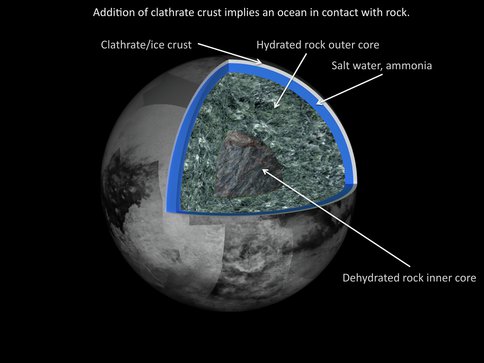2012 Annual Science Report
 NASA Jet Propulsion Laboratory - Titan
Reporting | SEP 2011 – AUG 2012
NASA Jet Propulsion Laboratory - Titan
Reporting | SEP 2011 – AUG 2012
Task 1.1.1 Models of the Internal Dynamics: Formation of Liquids in the Subsurface and Relationships With Cryovolcanism
Project Summary
The effort focused on establishing the geologically-determined conditions for organic evolution in the surface and interior. Using the standard prescription for modeling of satellite interiors, novel equations of state and thermal parameters were included that more realistically simulate Titan’s interior. The new value of the tidal love number for Titan was considered, along with inclusion of crustal clathrate. The likelihood of direct contact between an interior ocean and rock, as well as the cycling of hot water from rock to ocean, was demonstrated. The result raises the interest of Titan as an astrobiologically significant object in the solar system.
Project Progress
Deputy PI Jonathan Lunine continued to collaborate with colleague Julie Castillo-Rogez and Co-Investigator Christophe Sotin on models of Titan’s deep interior that best fit Cassini constraints. Building on work published in 2010, the new work combines two ideas: the hydrated silicate core, and an older idea that the crust of Titan-the outermost layer-is composed of gas hydrates of primarily methane. Gas hydrates (or clathrate hydrates) are common in the seafloor sediments of the Earth where they represent a major sink of methane and carbon dioxide. The gas hydrates insulate Titan’s deep interior, keeping it warmer over geologic time than would plain water ice. Indeed, at Titan’s surface temperature, water ice conducts heat very efficiently, 10 to 100 times more than clathrate hydrates.
The new results, presented by Lunine at the EGU in April 2012, are striking. Through much of geologic time, the warmth of Titan’s interior ensures that the silicate core of Titan is in direct contact with a liquid water ‘mantle’ surrounding it (Figure 1). An intervening ice layer—seen in more standard models—only appears very late in Titan’s history. The model also shows that late in Titan’s history the core heats up sufficiently to liberate water from the rock-a process called “dehydration”. The hot water will percolate through the rock to melt the ice, at least in places, so that portions of the silicate core may still be in contact with liquid water. It is a close analogue to the terrestrial environment that has been envisioned as a starting point for life on Earth. Because Titan is the only body with an internal water ocean (confirmed this year by Cassini) known to have organics, the base of this ocean may be the closest analog in the solar system to the state of the Earth’s oceans when life began.
The bursting forth of hot water from the deep interior might eventually affect the crust of Titan at the top of the ocean, leading to release of methane from the gas hydrates-methane that Cassini observes in the air, clouds, seas and lakes of Titan. The model suggests that such a process may have started recently and be currently ongoing.
Figure 1. – Addition of clathrate crust implies an ocean in contact with rock.
-
PROJECT INVESTIGATORS:
-
PROJECT MEMBERS:
Christophe Sotin
Co-Investigator
Julie Castillo-Rogez
Collaborator
-
RELATED OBJECTIVES:
Objective 2.2
Outer Solar System exploration
Objective 3.1
Sources of prebiotic materials and catalysts

